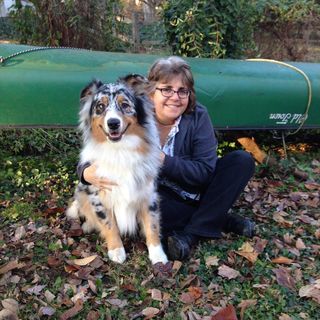Fear
It Makes No Sense to Punish a Fearful Dog
Food and kindness can increase the confidence of worried dogs.
Posted December 1, 2014 Reviewed by Gary Drevitch

by Ilana Reisner, DVM, PhD, DACVB
Fear and anxiety are at the root of many dog behavior problems. Some – like growling at strangers, urine marking or jumping without permission — may not seem to be anxiety-related, but in fact they often are. If you’re tempted to punish a behavior but are not sure about its motivation, err on the side of kindness and try a different strategy. If the unwanted behavior is truly voluntary, try positive reinforcement of a different behavior. But if it’s an emotional, stress-based behavior, take your dog out of the situation as quickly as possible, or try associating the “scary thing” with bite-sized liver treats, a squeaky toy, or just happy talk.
First, let’s clarify what punishment actually is. In order for it to work, three conditions have to be met: It must be immediate; it must happen 100 percent of the time; andit must be aversive or “nasty” enough to inhibit the behavior. That third condition is key. Punishment will not work if it’s not bad enough to the individual being punished. To one dog, a sharp reprimand might be aversive enough, but to another it’s only a bit of white noise. If that’s the case, the punisher might be tempted to escalate to yelling, sharp leash pops, hitting, and shock. But such methods are not recommended because:
- Fear and anxiety are not voluntary. Dogs cannot turn them on and off at will. If you think that’s untrue, try increasing your heart rate and making your palms sweat by thinking about it.
- Again, the punishment itself must be truly nasty in order to work. Punishing a fearful animal will therefore likely increase, not decrease, its fear. And the nastiness of the experience is judged by the dog, not by the punisher. It matters not one whit whether a shock feels like a "tickle" on your human arm.
- Anxiety and fear are not the same thing. Anxious animals are more susceptible to stress than non-anxious animals. Punishment of fear-based behavior can increase risk of aggression at the moment, but punishment of an anxious dog may have more insidious and long-lasting consequences.
- Dogs that have bitten in the past are more likely to bite owners who punish them for the aggression (Herron, Shofer, Reisner 2009). Not less likely – more likely. That is not the definition of success. And, yes, most dog bites are rooted in fear.
Fearful dogs lack confidence and are already stressed, and punishing them for manifesting those things will not make them better. This doesn’t mean that undesirable behavior can’t be changed: It can and should be. It’s a misconception that force-free trainers (those using primarily positive reinforcement) overlook and even coddle dogs that are aggressive, jumping up, stealing food, or chewing shoes. A good behaviorist or trainer will change inappropriate behavior without using punishment, regardless of whether fear is involved. Dogs are absolutely able to learn good manners by the use of positive reinforcement for good behavior and lack of reinforcement for undesired behavior. Anyone who has ever tried to train an unconventional species – say, a chicken – knows that handling an animal with coercive, force- or pain-based training methods can lead to fear, stress, resistance, and even learned helplessness. After all, chickens do not have an agenda for taking over the human world, and neither do dogs.
So what should you do if your dog is frightened? The best strategy is a combination of avoiding the “scary thing” (getting farther away from it) and then helping the dog to associate it – from a distance – with good things. Watch your dog for signs of nervousness, and start to "change the channel" — say, from big, scary men with umbrellas to bits of hot dog — early. It’s absolutely OK to reassure your dog by feeding, petting, and talking softly: This will not reinforce the fear, which cannot be turned on and off. Or ask your dog to perform an easy, distracting cued behavior such as touching your hand, and shower positive reinforcement for doing it. Punishment, on the other hand, can lead to fear of the punisher (you) and of the associated stimuli. If your dog lunges at skateboarders and you apply a leash correction, he might stop lunging for the moment, but is likely to be more fearful of both skateboarders and of your reactions on your next walk. Instead, to manage his fear, associate skateboarders (at a safe distance) with food, a toy, or a few familiar cues. Remember, the goal should be to increase your dog’s confidence and decrease his worries – not the reverse.
This is more than simply quibbling over semantics: Words can influence our actions. Permission to use force-based training methods (sometimes couched euphemistically as “balance”) implies consent to scruff, alpha-roll, and choke dogs, none of which is necessary for “controlling” their behavior. Dog owners/guardians who choose kinder training methods live with dogs who not only have good social skills but are also happier, more resilient, and visibly confident.
“Neither comprehension nor learning can take place in an atmosphere of anxiety” – Rose Kennedy
Further reading
Herron ME, Shofer FS, Reisner IR. (2009) Survey of the use and outcome of confrontational and non-confrontational training methods in client-owned dogs showing undesired behaviors. Applied Animal Behaviour Science, 117 (2009) 47–54


